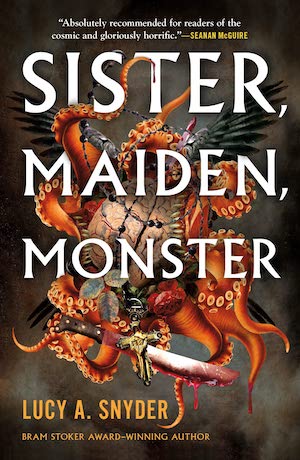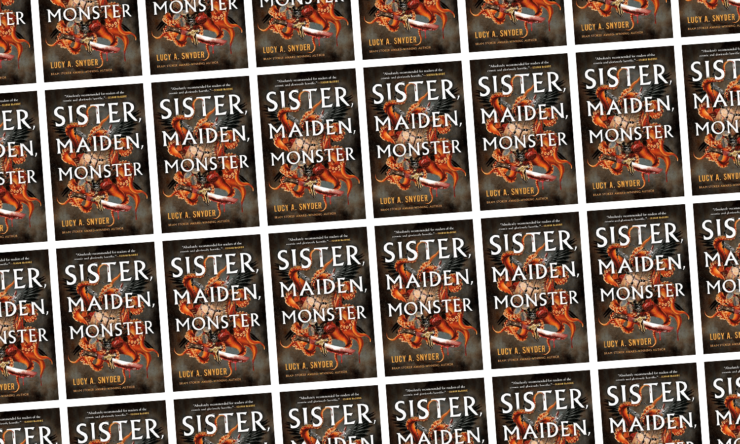Some years on from the coronavirus pandemic, the PVG virus has taken over the world. Since people more or less know how to manage pandemics, Erin continues to lead her regular life, making sure to wash her hands, wear a mask, carry on as best she can. One night, after her boyfriend sets up a romantic sushi dinner and marriage proposal, Erin starts to feel very unwell. Soon, she’s throwing up blood and stomach lining, and ends up in a secure facility for Type 3 patients of the PVG—the worst off of the ones effected, who are reliant entirely on mammalian brain matter to survive. What unfolds then is one of the more bizarre, gruesome stories in post pandemic horror fiction.
Lucy Snyder is a five-time Bram Stoker award winning writer, whose new novel Sister, Maiden, Monster is a no holds barred look at how women are affected by a pandemic that is bigger, worse and more eldritch than anything the world has ever imagined. You’d be forgiven for thinking this was a zombie novel at the start, when Erin is told she has to live off brains, not be in crowds, and not have any close relationships with anyone. But this is not a zombie novel. It would be simpler if it were, but Snyder veers wildly into otherworldly territories, wild even as compared to an all out limbs flying, blood spraying, everyone dying zombie apocalypse.
Sister, Maiden, Monster was developed from Snyder’s 2014 short story “Magdala Amygdala”, which centered on Erin, one of the novel’s three protagonists. Erin’s is the first voice, sex worker Savannah next, and lonely meek Mareva is our final girl. Erin’s learning how to live with her new identity, Savannah has just figured out who she is in the grand scheme of things (and how it really turns her on), and Mareva is going to find out just how valuable her unique medical condition is to the future of life on earth. Whether it’s the life she wants or not, is not really up to her. Their timelines sometimes run parallel, sometimes culminate.
Buy the Book


Sister, Maiden, Monster
It’s hard to go into further plot details without spoilers, but it’s no spoiler to say that this is not one of the ‘what did I just read’ variety of books, but more the ‘what am I reading’ variety, because it’s hard to fully suspend disbelief for the entirety of the three narratives. They sound a little like they could be the voice of one woman as she evolves, but perhaps that’s the point.
Snyder uses these characters’ voices to make pointed commentary on women’s health, capitalism, human rights, surveillance apps and various other very current valid topics, frequently and not very subtly, but then subtle isn’t at all what she’s going for. In fact, it’s all completely in your face excessive—the sex, the gore, the violence, the absolutely absurd leaps and bounds from earth to the gods know where. It’s a B movie, it’s cosmic horror meets Cronenberg meets Texas Chainsaw Massacre meets your worst Biblical nightmare. Can one connect gratuitous body horror, the grotesque, explicit sex, violence and gore to modern day critiques of gender, sexuality, socioeconomic politics and race? Sure. It is all just too much? Yes, but then so is the world of this novel.
Certain aspects of the story could leave a bad aftertaste, even for those who aren’t bothered by the obvious body horror. Why do a gay couple end up monstrous, viciously eating humans? Perhaps their being queer is incidental, and they’re just some of the many who end up this way, and they are eventually favoured by the new/old gods, their eldritch masters. Why must a BDSM switch find that her new role of extreme sadistic violence and murder gives her an orgasm each time she drives a machete into someones skull? A surviving character is asexual, but does that mean this is just playing into the old horror trope of the final girl, in which in order to persevere and survive a woman must have no interest in sex?
It can get a bit confusing: we are to empathise with these narrators, women who are suddenly ripped from their daily lives and changed into something monstrous by a virus (the source of which is a topic of great internet and YouTube debate, conspiracies of the ‘it can’t possibly be natural’ abound, all of which will be familiar to anyone who received random forwarded messages over WhatsApp from their bored aunties and uncles in Covid lockdowns), but it’s not clear whether we’re meant to think these women are on the side of good or evil… or whether those sides are even binary, or in the realm of human understanding. Which of course, is Lovecraft’s version of horror after all—something so beyond human understanding that it would cause sheer madness to even attempt to decipher it.
Which is a familiar feeling through much of this novel.
We can call it cosmic horror and write off some things as a spiritual fervour or eldritch ekstasis, which may make some of the say, particularly gnarly pleasure Savannah has from committing gruesome crimes a tiny bit more palatable, but the brutal truth is (and there is a lot of brutality here), Snyder isn’t going for palatable. Sister, Maiden, Monster is meant to evoke just the most visceral, violent, physical kind of existential dread that reminds you again and again that the world really is ending, we have no control over any of it, and unless some ancient gods in a benevolent mood happen upon some of us, it’s going to be game over for humanity in the most nightmarish of ways.
One question remains: when does the horrific become absurd? That’s a line really unique to each reader.
Sister, Maiden, Monster is published by Nightfire.
Mahvesh loves dystopian fiction and appropriately lives in Karachi, Pakistan. She writes about stories when not wasting much too much time on Twitter.











It made me flinch.best book so far this year